
As the name suggests, a basic life support course teaches you the basics of how to help someone who’s in cardiac arrest. The good news is that you don’t need to be an expert in order to save someone’s life with this technique! By taking a basic life support course, you’ll learn everything you need to know about performing cardiopulmonary resuscitation (CPR) and using an automated external defibrillator (AED). Here’s how a basic life support course can teach you to save lives.
Basic life support is the act of providing cardiopulmonary resuscitation (CPR) and artificial ventilation for victims of cardiac arrest or near-drowning. When someone suffers from cardiac arrest, their heart stops beating, depriving them of oxygenated blood and thus causing their brain to become hypoxic. Artificial ventilation refers to performing mouth-to-mouth breathing on the person in order to inflate their lungs with air and restore some level of oxygenation. CPR involves doing chest compressions and artificial ventilation in tandem. These two techniques are used until help arrives or an automated external defibrillator is used.
In the United States, approximately 325,000 people die each year from sudden cardiac arrest. That’s 1 person every 2 minutes. This is why it is so important to learn CPR and become a certified lifeguard. In the event of an emergency, these skills could save someone’s life. The American Heart Association recommends that everyone over age 9 knows how to perform CPR. Classes teach you the steps and techniques needed for saving someone’s life.
A basic life support course teaches you how to provide first aid until help arrives. It’s made up of three parts: CPR, choking and bleeding. CPR is used for cardiac arrest, choking is used for when someone has something stuck in their throat and bleeding is used for someone who has an injury that won’t stop bleeding. The first day is focused on teaching you how to assess the situation and what steps you should take before contacting emergency personnel. The second day focuses on providing hands-on training with mock emergencies using mannequins as the patient. Students will practice taking pulses and listening for breathing rates, doing compressions on fake chests, using suction devices to clear airways and turning people onto their backs if they’re not breathing. CPR involves pushing down on someone’s chest about 100 times per minute to simulate heartbeats in order to keep blood flowing to vital organs such as the brain and heart. At the end of each session students are given a quiz covering all content from both days. They are then certified after passing the test at no cost.
main photo: unsplash.com/Michel E